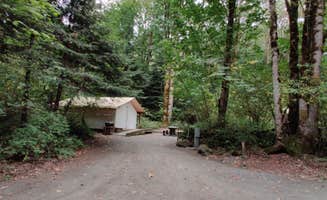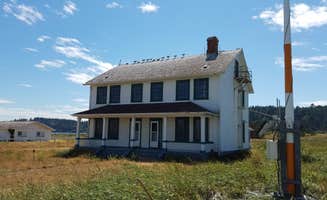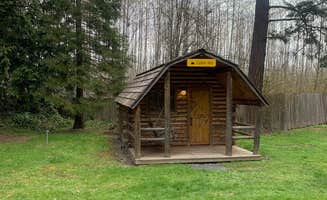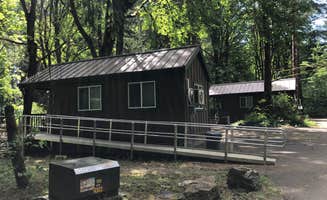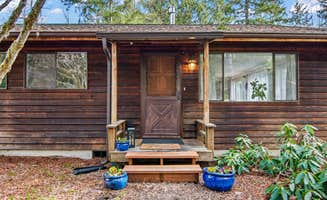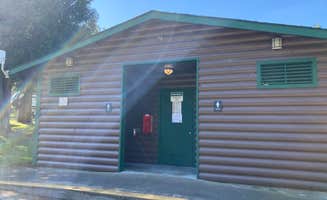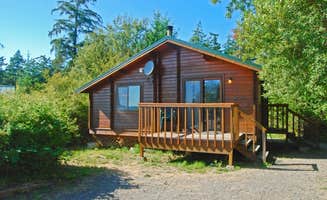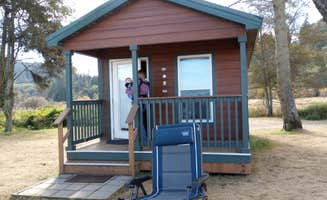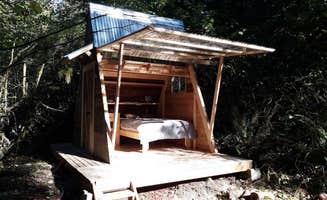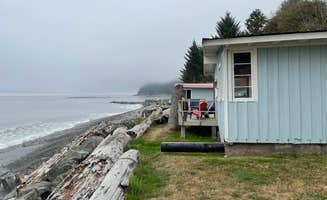Cabins near Quilcene, Washington offer direct access to the Olympic Peninsula's temperate rainforest environment, where annual rainfall averages 50-60 inches. Most rustic cabin accommodations sit at elevations between 300-800 feet above sea level, providing protection from coastal winds while maintaining proximity to waterways. Winter cabin occupancy drops by approximately 40% compared to summer months, making off-season visits less crowded.
What to do
Beach exploration at low tide: Fort Flagler Historical State Park offers excellent opportunities for beachcombing when tides recede. "You can walk the beach or walk the beautiful forest. Well maintained, great camphosts and a cool snack shack," notes Linda M. about Fort Flagler Historical State Park.
Historical fort tours: Explore military history through preserved gun batteries and bunkers. At Fort Worden, "There is a lighthouse that still functions and plenty of beach access. You could even play tennis here if you wanted," according to Ryan L. who visited Fort Worden State Park.
Shellfish harvesting: Seasonal clamming and oyster collecting permitted with proper licensing. "Been coming to this state park for as long as I can remember. There's so many activities to do; clamming, shrimping, hiking, hunting for oysters," reports Shariah T. about nearby beaches.
Wildlife viewing platforms: Dedicated observation areas for spotting Roosevelt elk herds, eagles and migratory birds. "Every night, my husband and I would walk to the wildlife viewing platform to see lots of birds, or walk down by the river and see lots of elk and bald eagles," shares Amy & Stu B.
What campers like
Water proximity: Many cabin sites offer direct views or access to water features. According to Daniel S., Camano Island State Park provides "Amazing views, lots to do and a wonderful place to spend some time. I look forward to going every year."
Range of privacy levels: Some parks feature cabins in secluded forest settings while others offer more communal arrangements. "The tent spots are clustered together in 2 areas with a shared covered pavilion," notes Sable about Fay Bainbridge Park, which also offers cabin accommodations.
Winter availability: Several parks maintain cabin rentals year-round with different reservation patterns. "Awesome fall and winter camping. First come first serve after Oct 31st. Spent a long weekend there last week. No problem finding 2 sites side by side," explains Mike K. about off-season opportunities.
Unique sleeping arrangements: Beyond standard cabins, platform tents provide alternative accommodations. "While it's quite basic it gave an amazing nature experience. We usually do tent camping, but we opted for platform tents here as we were only staying one night. The tent was much nicer than we expected," says Sara S.
What you should know
Site selection impacts experience: Choose locations strategically based on your priorities. "Do not choose a site by the cabins or field, you will be disappointed. Choose a large site by the river!" advises Michele K. about Dosewallips State Park.
Seasonal facilities availability: Some amenities close during winter months. "Website said water was turned off at the sites but all sites still had water... Docks are pulled out of the water during winter months. Upper campground is closed during winter," reports Mike K.
Variable site spacing: Parks differ significantly in how close cabins are positioned. "The camper spots are really close together. There is a big field to play ride bikes walk dog etc. The beach is really nice and nearby," Nicole R. explains about spacing considerations.
Noise considerations: Certain parks experience predictable noise patterns. At coastal locations near military installations, "You'll hear jets overhead on a regular basis," warns Will L., though he still rates his stay highly.
Tips for camping with families
Group-friendly facilities: Some sites specifically cater to larger parties or multiple families. "Stayed in the group site with my daughter's American Heritage Girls troop. We had 22 girls and there was plenty of room. This is a huge group site," shares Bridget S.
Beach safety for children: Shallow water areas provide safer swimming options. At Belfair State Park, "The beach was great, water is rather warm for in the sound, it's also pretty shallow which is great for the kids to play," according to Leah H.
Playground access: Several parks feature dedicated play equipment. Tanya B. notes, "Amazing kids area pirate ship. Great beach walk and good camp sites," making it ideal for families with children.
Trail difficulty variations: Parks offer paths suitable for different ages and abilities. "There are several hiking trail loops but the most appropriate for us was the beach trail which is maybe 2 miles to the beach and back," explains Michael B., who traveled with children ages six and one.
Tips from RVers
Hook-up variations: Water and electrical connections differ between parks and sometimes between camping loops. K D. warns that "Water pressure is low, averaging just over 20psi," which is important information for RV users planning water usage.
Site approach angles: Some sites require specific backing techniques. "RV sites 1, 2, 4, 9, and 11 will be easier to back in to. The other full hook up sites are 90° approaches," advises K D. about park layout at one location.
Winter closures and accessibility: Check which sections remain open during off-season. Brooks S. reports about Fort Casey State Park: "You used to be able to snag one of the standard campsites by driving in, selecting one then paying. Now, they all require registration year round."
Site leveling considerations: Most established parks maintain level surfaces. At one location, "RV sites are blacktop and level. Some sites have partial hookups w/o septic. Dump station is on site," according to James and Susan K.


